For more information about Effects in general, please see the Effects Rack Overview section.
Other Effects
The 'Other' submenu brings up a few more advanced modules which should function intuitively if you are familiar with the principles involved:
Fusion
The Fusion FX emulates the five key colour circuits found on the award-winning SSL Fusion hardware: Vintage Drive, Violet EQ, HF Compressor, Stereo Image, and Transformer. These modules provide five colouration tools designed to bring the perfect combination of added tonal character, weight and space to your mix bus or stereo stems. The Tempest version provides a single HPF for the entire chain, along with individual input and output trims for each processing block (as found in the plug-ins). Where relevant, the mix controls found on the plug-ins are also included.
All modules are provided in a single FX to enable simple inclusion on main and stem buses. Each processing block can be enabled individually, meaning blocks can be used individually, or combined as desired. The processing blocks can be reordered to achieve the desired processing order.
Fusion Vintage Drive

Vintage Drive is a unique non-linear harmonic enhancement circuit that brings cohesion and strength to your mix. Drive and Density controls interact to produce harmonic saturation and soft compression derived from overloading an analogue circuit. It can be used lightly for subtle thickening saturation or driven hard for more extreme distortion.
Fusion Violet EQ

Violet EQ is an all-new minimum phase-shift, two-band shelving EQ. It draws on the SSL legacy of carefully selected frequencies and response curves to create a musical and intuitive EQ designed to quickly dial in low-end weight and high-end sheen. High and Low frequency circuits each offer four switched frequency points and +/-9dB attenuation.
Fusion HF Compressor

High Frequency Compressor recreates the distinctive high frequency smoothing circuit from SSL Fusion. A compressor that effects high frequencies only, optimised for smooth and transparent harshness reduction and a tape-like high-frequency roll off, great for taming brittle high frequency fizz.
Fusion Stereo Image

Stereo Image enhancer provides a Mid-Side circuit that manipulates the Side signal, allowing for widening and spatial manipulation of the stereo field. The Space circuit is a frequency-dependent width control based on the concept of Stereo Shuffling, allowing injection of interesting depth effects into the mix. Stereo Image exposes a Shuffle control for changing the frequency cut-off in the Space circuit, allowing you to add weight and presence or carve space in the stereo field.
Fusion Transformer

Emulating the 600-ohm, 1:1-wound under-damped transformer found in the Fusion hardware, Transformer introduces subtle low-frequency saturation, alongside a high-frequency phase-shift. From subtle presence and body on vocals and instruments, to tight lows and sizzling highs on mixes and masters, the combination of processing effects Transformer offers could be the magic your mix or master is after. Use Shine to attenuate the HF phase shift and turn up the Amount control to amplify harmonic distortion. Both controls can be used to drive the processing effect beyond the original circuit found in the Fusion hardware.
Auto Pan
Auto Pan is an automated panning effects unit with a variety of modulation controls and tempo link.
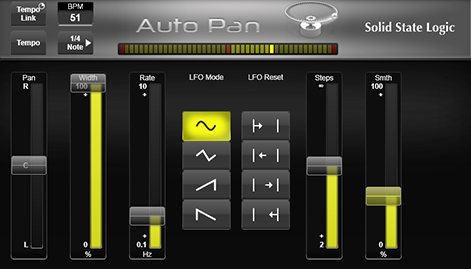
Auto Pan can be linked to the appropriate Tap Tempo User Key by pressing and holding Tempo Link just as with delay effects units.
The Pan and Width controls provide the ability to adjust the offset and boundaries of the panning algorithm within the stereo field.
The Rate control defines the speed at which the signal is panned from side to side. This updates automatically with input from the Tempo controls, but can also be adjusted manually.
LFO Mode determines the shape of the control signal used to modulate the pan setting. The options are sine, sawtooth or triangle.
LFO Reset buttons allow the user to reset the phase of the LFO to one of the following positions:
 |
From the Left edge |
 |
From the Centre to the Left edge |
 |
From the Centre to the Right edge |
 |
From the Right edge |
The Steps control allows the user to create a completely smooth panning movement (when Steps = ∞), or to pan through discrete, equally spaced, points (when Steps < ∞). For example, setting Steps = 2 will create points at 100% left and 100% right, resulting in a Ping Pong effect, alternating between left and right at the rate set by the Tempo/Rate controls. Steps = 3 will create an additional point in the centre, repeating the cycle 100% left, centre, 100% right, centre.
The Smooth control allows an amount of 'crossfading' between discrete points, so that the signal does not move between points so abruptly.
There is a Left-Right meter below the 'Auto Pan' title displaying where the AutoPan output signal is currently positioned in the stereo space.
De-Noiser
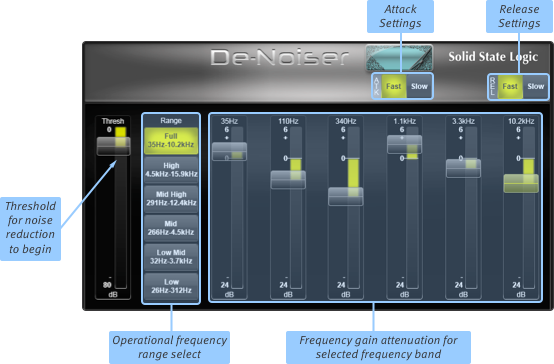
The De-Noiser module is a frequency-selective noise reduction algorithm, allowing you to dial in the 'shape' of the noise to eliminate it more effectively.
The six gain sliders control the wet/dry mix between the 'noisy' and de-noised signals in each band. At 0 dB gain, there is an equal mix between the noisy and de-noised signals. Increasing the gain increases the amount of the noisy signal added back into the mix.
Threshold sets the level of the noise. Anything below this is considered noise by the noise detection algorithm.
Range defines the frequency ranges over which the De-Noiser works. These are:
| Range | Band 1 | Band 2 | Band 3 | Band 4 | Band 5 | Band 6 |
|---|---|---|---|---|---|---|
| Full (35 Hz - 10.2 kHz) | 35 Hz | 110 Hz | 340 Hz | 1.1 kHz | 3.3 kHz | 10.2 kHz |
| High (4.5 kHz - 15.9 kHz) | 4.5 kHz | 5.8 kHz | 7.5 kHz | 9.6 kHz | 12.4 kHz | 15.9 kHz |
| Mid High (291 Hz - 12.12.4 kHz) | 291 Hz | 616 Hz | 1.3 kHz | 2.8 kHz | 5.8 kHz | 12.4 kHz |
| Mid (266 Hz - 4.5 kHz) | 266 Hz | 468 Hz | 825 Hz | 1.5 kHz | 2.6 kHz | 4.5 kHz |
| Low Mid (32 Hz - 3.7 kHz) | 32 Hz | 83 Hz | 215 Hz | 557 Hz | 1.4 kHz | 3.7 kHz |
| Low (26 Hz - 312 Hz) | 26 Hz | 42 Hz | 70 Hz | 115 Hz | 189 Hz | 312 Hz |
ATK and REL controls determine the Attack and Release speed of the filters.
Operation
- Set the Threshold to the appropriate level such that, in each band, everything below the threshold is 'noise' and everything above it is 'signal'. This can be done by setting the Range to Full, all the Gains to -24 dB, and then by slowly moving the Threshold up from -80 dB until the 'noise' disappears.
- Select the appropriate Range in which the noise resides. Any signal content outside the selected Range will not be affected by the De-Noiser.
-
Move the Gain faders to shape the noise reduction:
- If a negative Gain is selected, then EQ is applied to suppress the 'noise' when the level of the input is below the Threshold.
- If a positive Gain is selected, then EQ is applied to boost the 'signal' when the level of the input is above the Threshold.
Enhancer
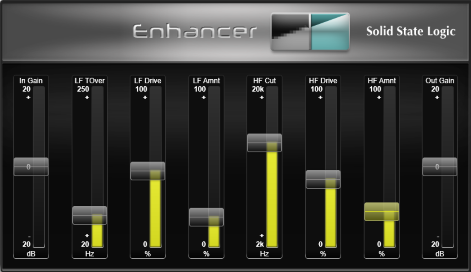
The HF controls add a combination of 2nd and 3rd order harmonics, which have the effect of enriching the high frequency range. This overdrive characteristic will work from the frequency set by the Cutoff control upwards with a varying amount of harmonic content. This process is not possible with a standard EQ, as instead of raising the relative level of a set of frequencies, it is adding harmonics to those frequencies therefore producing a more pleasing effect.
HF Cutoff: Ranging from 2 kHz up to 20 kHz, the this sets the frequency above which harmonics are generated. To add air or sparkle to a signal, push this frequency towards the higher end of the range. To give more presence to a signal, use the lower end of the range.
HF Drive: This adjusts the amount of overdrive and consequently controls the density and amount of harmonic content.
HF Amount: This adds the enhanced signal to the unprocessed signal.
Notes:
The HF Enhancer effect will not be heard until both the HF Drive and HF Amount faders are set to a non-zero value.
Also bear in mind that when the Cutoff control is in the 15 kHz to 20 kHz range, the effect may not be noticed even though it is present, because this is near to the top of the range of human hearing.
The LF Enhancer section is similar to the HF Enhancer, but works on the low frequency range from the LF TOver (turnover) frequency downwards. It's great for adding depth and weight to kick drums, snare or toms.
The incoming signal is low-pass filtered, harmonically enriched using the LF Drive control and added to the unprocessed signal using the LF Amount control.
Use the In Gain and Out Gain controls to adjust the incoming and outgoing signal levels for optimum signal level through the effect.
Amp Cabinet
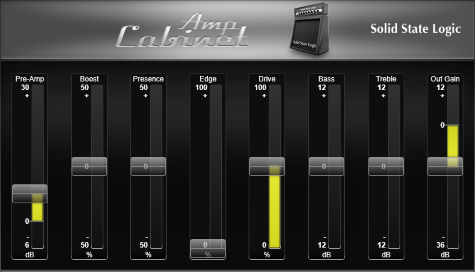
Uses oversampling to emulate a guitar amplifier.
Use Pre-Amp gain to adjust the input gain to the effect module.
Boost, Presence and Edge add low, mid and high frequency drive respectively.
Drive controls the amount of amp distortion.
Bass and Treble act as general tone controls for the overall effect.
Out-Gain determines the output gain from the effect module.
Bass Amp
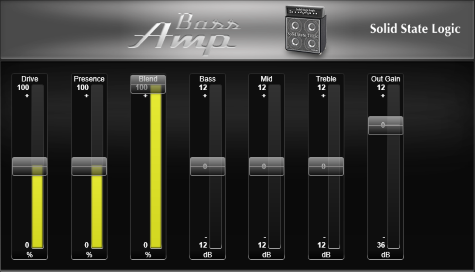
Uses oversampling to emulate a bass guitar tube amplifier.
Drive controls the amount of input gain, emulating overdriving a tube input stage.
Presence adds upper harmonic content to add more 'bite' to the signal.
Blend controls the amount of tube emulation added to the 'dry' signal.
Bass, Mid and Treble controls act as general tone controls for the overall signal.
Out-Gain determines the output gain from the effect module.
Pitch Shifter

The Mix control adjusts the amount of pitch shifted versus original signal is output from the effect module.
Use the Pitch controls to adjust the shift in pitch. The - semitone and + semitone buttons nudge the pitch in whole semitone increments, while the Fine slider allows finer adjustment of the pitch.
Double tap the text field to the left of the semitone buttons to enter a specific pitch shift value.
SubmoniX
SubmoniX is a sub-bass harmonic synthesiser with four individually controlled filters, each of which has discrete control of amplitude, frequency and bandwidth. This allows fine tuning of the frequency range and level of each synthesised band.
Individual filter in/out switching is provided by pressing the numbered IN buttons. Press & hold these to reset the selected band.
To access the frequency and bandwidth controls for each band, tap the Frequency button in the top left.
Sub Gain is used to control the overall gain of the synthesised bass signal. LF Boost adds frequency content between the synthesised bass and the original signal, allowing a more even low end frequency range. This can be used to increase the low frequency response even when no synthesised components have been added.
VHD Saturator
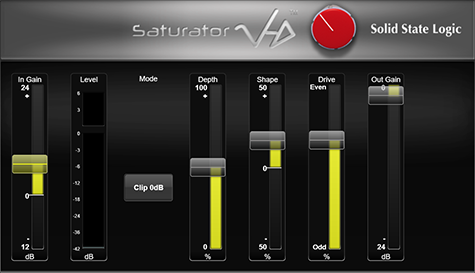
VHD Saturator delivers a range of analogue style distortion effects. It is an emulation of an analogue circuit that introduces either 2nd order valve style or 3rd order transistor style distortion or a blend of the two. At low drive settings the distortion is mild and can add gentle warming to help instruments sit nicely in a mix or to add a little extra edge to help instruments cut through a mix. As input gain levels are increased so too is the level of distortion until at high drive levels heavy distortion occurs.
The controls are:
- In Gain sets the drive level
- Clip 0dB provides an additional 6 dB of headroom for creating heavily boosted/distorted signals without digital clipping
- Depth controls the amplitude of the distortion
- Shape adjusts whether the distortion has smooth or hard edges
- Drive determines the blend of odd and even order harmonics. Increasing the Drive control increases the amount of even harmonics added
- Out Gain provides an output trim to adjust to final output level of the effect
Useful Links
Detail ViewEffects Rack Overview
Delay Effects
Dynamics Effects
EQ Effects
Modulation Effects
Reverb Effects
Audio Tools
Automix
Index and Glossary

